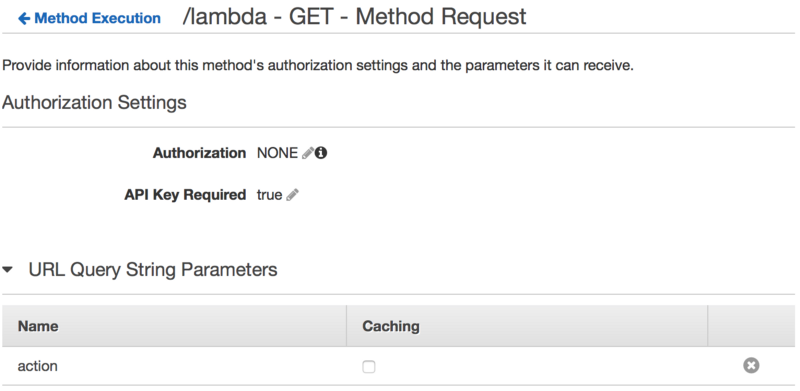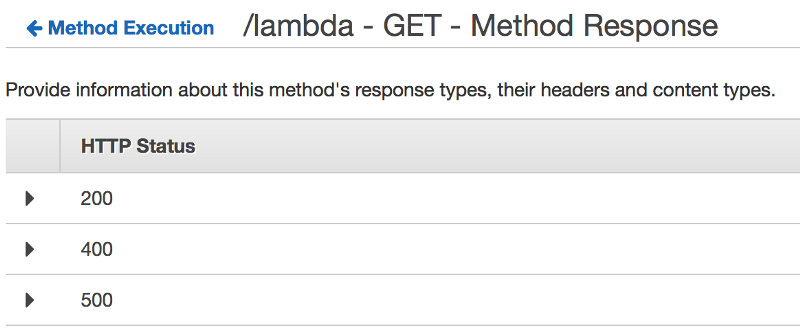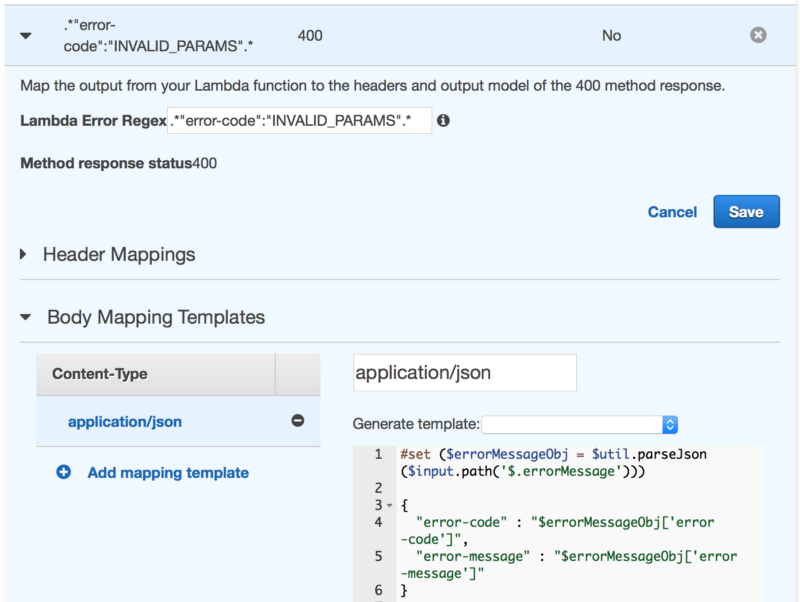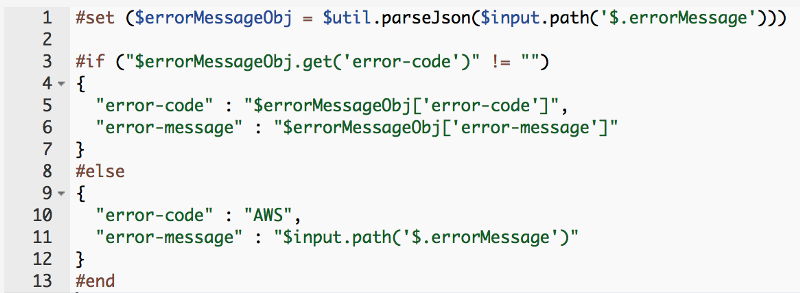It’s fragile and kind of terrible. Let’s look at it. We have a function named lambda. It has one argument named action (enum with allowed values data, exception or timeout). First thing we would like to do is to validate input via schema. Then we would like to return custom error message (and status code) if it’s invalid or do other things based on the action argument value.
Here’s the code, just to demonstrate how it works.
(defn- timeout [ms]
(let [c (chan)]
(js/setTimeout (fn [] (close! c)) ms)
c))
(defn- error
[code message]
(.stringify js/JSON (clj->js {:error-code code :error-message (pr-str message)})))
(def EventSchema
{:action (s/enum "data" "exception" "timeout")})
(def ^:export lambda
(async-lambda-fn
(fn [event context]
(go
(if-let [e (s/check EventSchema event)]
(fail! context (error "INVALID_PARAMS" e))
(try
(let [action (:action event)]
(cond
(= "data" action) (succeed! context {:some "data"})
(= "timeout" action) (<! (timeout 5000))
(= "exception" action) (throw (js/Error. "Oops"))))
(catch :default e
(fail! context (error "EXCEPTION" e)))))))))
I’m not going to describe how to deploy Lambda function or API Gateway basics. I assume you know how to do it. I’m going to focus on error handling only.
Our function is deployed, API Gateway resource (/lambda) and GET method created and deployed as well. All with default settings, just for now.
What happens when we try to use it?
curl -sw "n%{http_code}" -H "x-api-key: ..." -H "Accept: application/json"
https://...execute-api.eu-west-1.amazonaws.com/latest/lambda
{
"errorMessage": "{\"error-code\":\"INVALID_PARAMS\",\"error-message\":\"{:action missing-required-key}\"}"
}
200
JSON in JSON and status code is 200. That’s not what we want. At all.
Pass action from query to lambda function
POST method handles this automatically. Body is passed via event argument. But GET is a slightly different beast.

We have to add action to the URL Query String Parameters section. Then we have to add Body Mapping Template (BMT) in the Integration Request section.
{
"action": "$input.params('action')"
}
Redeploy API and test.
{
"errorMessage": "{\"error-code\":\"INVALID_PARAMS\",\"error-message\":\"{:action (not (#{\"data\" \"exception\" \"timeout\"} \"\"))}\"}"
}
200
Much better, we can see validation response. Let’s try some [in]valid options. Status code 200 for all of them with following responses.
action=data
{
"some": "data"
}
action=timeout
{
"errorMessage": "2016–04–14T12:20:20.584Z 3f0e0ca9–023b-11e6-a561-e58695fc8058 Task timed out after 4.00 seconds"
}
action=exception
{
"errorMessage": "{\"error-code\":\"EXCEPTION\",\"error-message\":\"#object[Error Error: Oops]\"}"
}
NOTE: Our lambda function is deployed with timeout set to 4 seconds. Just to make it working, check the code, we’re waiting 5 seconds.
This is not good. We want 200 for success, 400 for invalid input parameters and 500 if something bad happens (exception, timeout, …) and better structure of our response.
Mapping status codes
We have to add 400 and 500 in the Method Response section. Otherwise we’ll not be able to select these status codes in the Integration Response section.

If lambda function fails, it returns JSON in the following format:
{
"errorMessage" : "whatever"
}
And the errorMessage is a string. Do you want to return more than just a string? You have to encode it.
Open the Integration Response section and you’ll see something like this:

Default mapping uses 200 for the status code, there’s no regex and Body Mapping Template (click on the triangle) is empty = passthrough. And because we know what our Lambda function returns, we can add some regular expressions there.

What’s this all about? Lambda Error Regex column contains regular expressions that are matched against errorMessage from the lambda response if it indicates it failed (fail! in the code). For INVALID_PARAMS we would like to return 400, for any other error message (.+_) we would like to return 500 and 200 for the rest.
Redeploy and test.
action=exception
{
"errorMessage": "{\"error-code\":\"EXCEPTION\",\"error-message\":\"#object[Error Error: Oops]\"}"
}
500
action=timeout
{
"errorMessage": "2016–04–14T12:41:09.348Z 27638414–023e-11e6-bcf3–89b1797fdc7b Task timed out after 4.00 seconds"
}
500
action=hallo
{
"errorMessage": "{\"error-code\":\"INVALID_PARAMS\",\"error-message\":\"{:action (not (#{\"data\" \"exception\" \"timeout\"} \"hallo\"))}\"}"
}
400
action=data
{
"some": "data"
}
200
Better response structure
Status codes solved. Now we have to focus on the response structure. It’s quite simple. We can do it in the Integration Response section as well. We have to add Body Mapping Template for each regular expression we already added.


As you can see, BMT for 500 is more fancier that the one for 400. Why? AWS can kill our lambda function because of timeout for example and then there’s just plain string in the errorMessage. Also our lambda can catch exception, send back custom error map and then there’s encoded JSON in the errorMessage. And because we can’t add two (or more) regular expressions for the same status (500 in this case), we have to handle it in the BMT.
Redeploy and test.
action=exception
{
"error-code": "EXCEPTION",
"error-message": "#object[Error Error: Oops]"
}
500
action=timeout
{
"error-code": "AWS",
"error-message": "2016–04–14T13:50:09.212Z caf1daed-0247–11e6–91f8-d9f9a69fef2c Task timed out after 4.00 seconds"
}
500
action=hallo
{
"error-code": "INVALID_PARAMS",
"error-message" : "{:action (not (#{\"data\" \"exception\" \"timeout\"} \"hallo\"))}"
}
400
action=data
{
"some":"data"
}
200
Goal reached. Status codes and better response structure for errors. It’s not perfect, there’s always room for improvement, but it works.
It’s a bare minimum you have to do. Pretty rough, okay, terrible, but when you know how to do it … Hope it helps, because I spent quite huge amount of time on this.